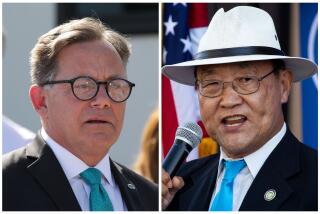Unions Seeking to Increase Clout in Suburban Races
- Share via
The roughly 260 union volunteers in state Sen. Hilda Solis’ successful congressional campaign last week opened a new front for organized labor: the suburbs of Los Angeles County.
Manning telephones and trolling San Gabriel Valley neighborhoods for votes, union workers were instrumental in Solis’ overwhelming defeat of 18-year incumbent Rep. Matthew G. Martinez in the Democratic primary.
“I wouldn’t be here, were it not for my friends in the labor movement,” Solis said in her victory speech last week before a raucous crowd in an El Monte dance club.
Organized labor hopes November will bring more praise from Democratic winners in other corners of the county.
With a boost in union membership of 91,000 workers last year--the largest increase since the 1930s--Los Angeles labor leaders are seeking to become key players in suburban politics. Their work for Solis and six other successful candidates in Tuesday’s primary was only a dress rehearsal for critical races this fall in the South Bay and the San Fernando Valley.
“You’ll see a lot of emphasis in the Harbor and the Glendale-Burbank areas,” said Fabian Nunez, political director of the Los Angeles County Federation of Labor. “For us, [the Solis race] was a good example of how we want to play a bigger role in the agenda outside of L.A.”
In the past, organized labor limited its efforts to the city of Los Angeles and nearby neighborhoods. The suburbs, Nunez said, have historically been unreceptive to labor issues.
But that is no longer so, as more working-class families move to such cities as Covina, Burbank and Torrance and as unions benefit from growing numbers of teachers, government employees and home health care workers.
Coupled with the high turnover of legislators caused by term limits, the changing terrain in the suburbs gives unions a potentially powerful hand in local politics.
With term limits, “You don’t have the strong power brokers among state legislators that you had in the days of [former Assembly Speaker] Willie Brown,” said Jack Pitney, a professor of government at Claremont McKenna College. “When there’s a vacuum, there is an opportunity for other forces to fill it, such as organized labor.”
Massive union support for Solis, 42, roused the electorate in the 31st Congressional District. Claiming that Martinez, 71, had lost touch with his district, Solis scored an overwhelming victory--winning 69% to 31%.
Volunteers came from as far away as Delano and the Coachella Valley to rally 26,500 union members in the district who said they would vote for Solis.
In phone calls and on porches, they trumpeted Solis’ work in raising the state minimum wage, tightening pesticide regulations and improving family health care programs.
“We want someone who will champion our issues,” said Alex Espinoza, head of a Baldwin Park service employees’ local.
Martinez was a reliable labor vote in the past--which secured him endorsements from a handful of smaller local unions. But more recently, he has been seen as weak on labor issues and generally ineffectual.
Miguel Contreras, head of the county’s labor federation, said his group hopes to have the same impact this November in the San Fernando Valley and the South Bay.
In addition to campaigning on behalf of Vice President Al Gore, they expect to pour money and manpower into at least two congressional races seen as key battlegrounds in the Democrats’ effort to regain control of the House of Representatives.
They are state Sen. Adam Schiff’s drive to unseat James E. Rogan (R-Glendale) in the 27th District, and former Democratic Rep. Jane Harman’s bid to regain the 36th District’s South Bay seat from Rep. Steven T. Kuykendall (R-Rancho Palos Verdes).
“If everything is done right, we have a shot of winning back half of what the Democrats need right here in Los Angeles County,” Contreras said. His organization also is considering trying to unseat Rep. Steve Horn (R-Long Beach) in the 38th District.
In Rogan’s district, which encompasses Burbank, Glendale, Pasadena and La Canada Flintridge, there are roughly 48,000 registered voters, out of a total of about 298,000, who belong to unions, the labor federation said. In Kuykendall’s district, which encompasses San Pedro, Torrance, Venice and other beach communities, about 30,000 voters (from a total of 330,000) belong to unions.
The union jobs in Glendale and Burbank include work in the entertainment industry and education. Union voters in the South Bay and Long Beach work primarily at oil refineries, ports and aerospace and defense industries.
The strategy to mobilize those groups will be the same, Contreras said, boasting that his organization has been successful in nearly all of the 17 local contests the federation has fought since 1997.
With the aim of sharpening its role in the region’s political battles, the labor federation has stopped a long practice of simply writing checks to candidates.
In the last three years, it has run its own campaigns in priority races, using union members to walk precincts, help with campaign mailers and phone other union members.
The federation also conducts voter-registration drives for newly naturalized immigrants--whether or not they belong to unions--a key voting group in predominantly minority suburbs, including those in the San Gabriel Valley, Nunez said.
Given its increasing influence, Contreras said, organized labor in Los Angeles County has the luxury of devoting greater resources to those it considers proactive candidates, like Solis.
Labor-backed candidates who won Tuesday, Contreras said, “have been on our picket lines and at our demonstrations. And all have helped pass living-wage laws or battled against the [nonunion] ‘big box’ stores.”
Where such standards might have been too radical in the suburbs 20 years ago, they are now mainstream ideas in the changing landscape of Los Angeles County, said Alan Heslop, director of Claremont McKenna’s Rose Institute, which analyzes local politics and demographics.
Suburbs became fertile ground for labor organizing during the recession of the early 1990s, when corporate downsizing and flourishing temporary-employment agencies killed thousands of permanent jobs, he said.
Along with growing numbers of blue collar workers moving into the suburbs, unions have also latched onto high-tech workers, such as those in the San Gabriel Valley foothills and Long Beach, Heslop said.
“With that occurred a renaissance of the unions’ political power,” Heslop said. He estimates that between 20% and 40% of high-propensity voters in the San Gabriel Valley’s foothills either belong to unions or have union members in their families.
With the labor federation’s efforts, which include smaller roles in several state races in the county, Nunez said, his organization hopes to rally union households into a single voting bloc.
“Winning these campaigns is not the end goal,” Nunez said. The real objective, he said, is building union strength in new neighborhoods.
More to Read
Get the L.A. Times Politics newsletter
Deeply reported insights into legislation, politics and policy from Sacramento, Washington and beyond. In your inbox twice per week.
You may occasionally receive promotional content from the Los Angeles Times.











